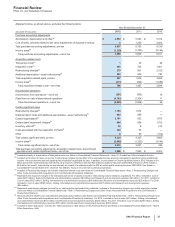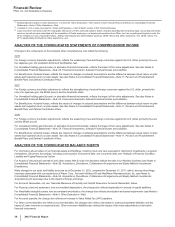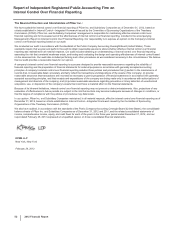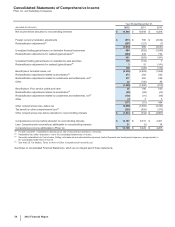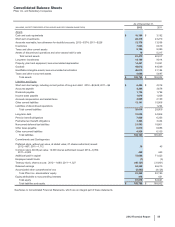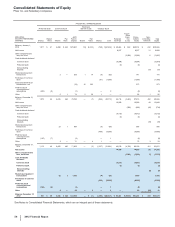Pfizer 2012 Annual Report Download - page 48
Download and view the complete annual report
Please find page 48 of the 2012 Pfizer annual report below. You can navigate through the pages in the report by either clicking on the pages listed below, or by using the keyword search tool below to find specific information within the annual report.
Financial Review
Pfizer Inc. and Subsidiary Companies
2012 Financial Report
47
Foreign Exchange Risk
A significant portion of our revenues and earnings is exposed to changes in foreign exchange rates. We seek to manage our foreign exchange
risk, in part, through operational means, including managing same-currency revenues in relation to same-currency costs and same-currency
assets in relation to same-currency liabilities.
Foreign exchange risk is also managed through the use of foreign currency forward-exchange contracts. These contracts are used to offset
the potential earnings effects from mostly intercompany short-term foreign currency assets and liabilities that arise from operations. Foreign
currency swaps are used to offset the potential earnings effects from foreign currency debt. We also use foreign currency forward-exchange
contracts and foreign currency swaps to hedge the potential earnings effects from short-term and long-term foreign currency investments,
third-party loans and intercompany loans.
In addition, under certain market conditions, we protect against possible declines in the reported net investments of our Japanese yen
subsidiaries. In these cases, we use currency swaps or foreign currency debt.
Our financial instrument holdings at year-end were analyzed to determine their sensitivity to foreign exchange rate changes. The fair values of
these instruments were determined using various methodologies. For additional details, see Notes to Consolidated Financial Statements—
Note 7A. Financial Instruments: Selected Financial Assets and Liabilities. In this sensitivity analysis, we assumed that the change in one
currency’s rate relative to the U.S. dollar would not have an effect on other currencies’ rates relative to the U.S. dollar; all other factors were
held constant. If the dollar were to appreciate against all other currencies by 10%, the expected adverse impact on net income related to our
financial instruments would be immaterial. For additional details, see Notes to Consolidated Financial Statements—Note 7E. Financial
Instruments: Derivative Financial Instruments and Hedging Activities.
Interest Rate Risk
Our U.S. dollar interest-bearing investments, loans and borrowings are subject to interest rate risk. We also are subject to interest rate risk on
euro debt, investments and currency swaps, U.K. debt and currency swaps, Japanese yen short and long-term borrowings and currency
swaps. We seek to invest, loan and borrow primarily on a short-term or variable-rate basis. From time to time, depending on market
conditions, we will fix interest rates either through entering into fixed-rate investments and borrowings or through the use of derivative financial
instruments such as interest rate swaps. In light of current market conditions, our current borrowings are primarily on a long-term, fixed-rate
basis. We may change this practice as market conditions change.
Our financial instrument holdings at year-end were analyzed to determine their sensitivity to interest rate changes. The fair values of these
instruments were determined using various methodologies. For additional details, see Notes to Consolidated Financial Statements—Note 7A.
Financial Instruments: Selected Financial Assets and Liabilities. In this sensitivity analysis, we used a one hundred basis point parallel shift in
the interest rate curve for all maturities and for all instruments; all other factors were held constant. If there were a one hundred basis point
decrease in interest rates, the expected adverse impact on net income related to our financial instruments would be immaterial.
Contingencies
Legal Matters
We and certain of our subsidiaries are subject to numerous contingencies arising in the ordinary course of business, such as patent litigation,
product liability and other product-related litigation, commercial litigation, environmental claims and proceedings, government investigations
and guarantees and indemnifications (see Notes to Consolidated Financial Statements—Note 17. Commitments and Contingencies).
Certain of these contingencies could result in losses, including damages, fines and/or civil penalties, and/or criminal charges, which could be
substantial.
We believe that our claims and defenses in these matters are substantial, but litigation is inherently unpredictable and excessive verdicts do
occur. We do not believe that any of these matters will have a material adverse effect on our financial position. However, we could incur
judgments, enter into settlements or revise our expectations regarding the outcome of certain matters, and such developments could have a
material adverse effect on our results of operations in the period in which the amounts are accrued and/or our cash flows in the period in which
the amounts are paid.
We have accrued for losses that are both probable and reasonably estimable. Substantially all of these contingencies are subject to significant
uncertainties and, therefore, determining the likelihood of a loss and/or the measurement of any loss can be complex. Consequently, we are
unable to estimate the range of reasonably possible loss in excess of amounts accrued. Our assessments are based on estimates and
assumptions that have been deemed reasonable by management, but the assessment process relies heavily on estimates and assumptions
that may prove to be incomplete or inaccurate, and unanticipated events and circumstances may occur that might cause us to change those
estimates and assumptions.


